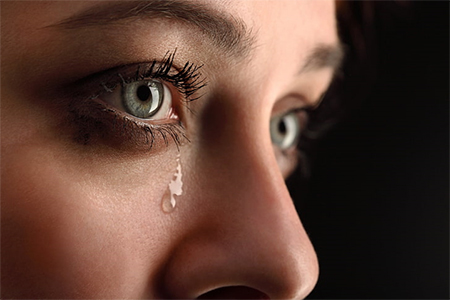 | |
Basal tears have three different layers, oily, aqueous, and mucin. Eyes constantly shed basal tears to coat the eye, supply nutrients to the outer structures of the eye, protect the cornea, and lubricate the eye. Dust, follicles, or debris in the eyes, are cleared by basal tears.
Reflex tears are made in the lacrimal gland and consist mostly of water. The body makes these tears as a reflex to a stimulus. For example: if a large particle flies into the eye, the eye tears to flush it out.
Emotional tears are the tears made when one is overcome with emotion. Scientists have found traces of stress chemicals in tears that could mean that crying is a way of relieving stress. Additionally, some studies suggest that crying stimulates the body to produce endorphins, the ‘feel-good’ chemical produced by the brain. Recent studies have shown the phenomenon of emotional tears to have positive physiological and psychological effects, even if they aren’t tears of joy.
According to a recent article in News-Medical.net, (Dutta, Sanchari Sinha. "How Crying Could Actually Boost Your Mood". News-Medical. 26 September 2022. <https://www.news-medical.net/health/How-Crying-Could-Actually-Boost-Your-Mood.aspx>.) a social or psychological effect of crying occurs when others observe someone cry. It often elicits empathy, compassionate, supportive, and protective responses in other people. There are gender differences in frequency of crying that may be physiological, but more likely psychological. A woman cries on average 5 times a month, whereas a man cries only once a month. The levels of hormones such as testosterone and prolactin might play a role in reducing crying in men and inducing crying in women. However, the negative social view of men crying plays a major role in controlling their response.
Scientific evidence suggests that crying improves mood via physiological, cognitive, and behavioral mechanisms. Activation of the parasympathetic nervous system has been observed during the resolution of crying. In physiological conditions, this activation is associated with rest, recovery, and relaxation processes. Tears also help clear and detoxify the blood by removing toxins and stress hormones, such as cortisol.
Emotional tears contain higher levels of stress hormones and natural pain-relieving substances than basal tears. Crying is known to increase pain tolerance, possibly associated with the release of internal opioids that relieve physical and emotional pain. It also increases the secretion of oxytocin, a hormone that helps cope with stress. What’s more, tears contain nerve-growth factor, a protein found in the lacrimal gland. Nerve-growth factor, which is crucial for the growth and survival of neurons, is believed to play a role in enhancing mood during crying and modulating depression. Holding back negative emotions and tears is known as repressive coping, and studies have found that it can weaken the immune system and increase the risk of cardiovascular diseases, hypertension, and mental health conditions, such as anxiety, depression, and stress.
Crying is a natural behavior that occurs in response to a range of emotions, happy, angry, and sad, and emotional tears can have benefits beyond eye health. So have a ‘good’ cry if you want to! You can learn more about the source and composition of tears with our CE, The Quality of Tears and Contacts, at 2020mag.com/ce.













